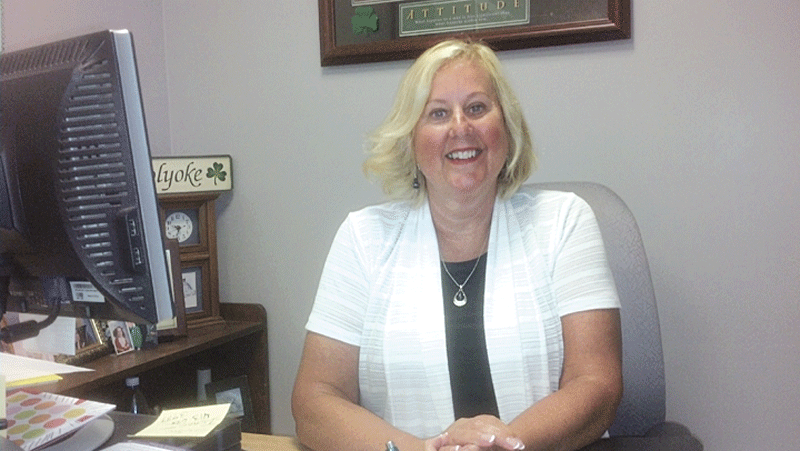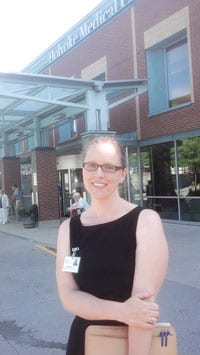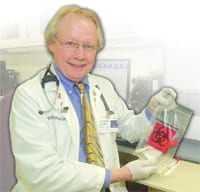Extending Its Reach – Holyoke Medical Center Tackles Nutrition, Wellness in the Community
Helen Arnold says there’s a responsibility to being a community hospital in a city struggling with pervasive poverty.
For instance, said Arnold, director of Community Benefits at Holyoke Medical Center, 82.6{06cf2b9696b159f874511d23dbc893eb1ac83014175ed30550cfff22781411e5} of Holyoke’s public-school students receive free or reduced-price lunch, and many aren’t getting proper nutrition at home. In fact, 30{06cf2b9696b159f874511d23dbc893eb1ac83014175ed30550cfff22781411e5} of Holyoke residents live in a ‘food desert,’ a term for an area where fresh produce and other healthy food options are not within walking distance.
“So we’re working really hard educating people and making sure everyone has what they need,” she told HCN, noting that the average income in the Paper City is $34,496, far below the state average, and typically, poorer communities don’t access fresh, healthful food options to the degree higher-income cities do. “We really have to be out there helping people getting educated and moving ahead. That’s a big part of it.”
For example, the hospital runs a fill-the-backpack program that provides poor or homeless students with a satchel of healthy food to last the weekend, days when they don’t have access to the school-lunch program. It’s just one of many community benefits the hospital provides, with other programs in place to combat obesity, poor school performance, infant mortality, crime, and issues of general wellness.
“These are things we’ve always been known for; I’ve been with Holyoke Medical Center for three years, and many of these programs were already in place,” said Rebecca MacGregor, marketing and development supervisor for the hospital, whose oversees a series of educational programs at HMC and outside it. “We want to be good community partners — in fact, we’re required to provide community benefits, give back to the community, to maintain our nonprofit status. But we’ve always done these things.”
In fact, the state Attorney General’s Office released a report in 2009 outlining what types of community programs are expected of hospitals and health plans. “The guidelines do not dictate the specific types of programs that hospitals and HMOs must provide,” the report states. “Rather, they encourage hospitals and HMOs to use their expertise and resources, as well as the expertise of their communities, to target the particular needs of underserved and at-risk populations.”
Implementation of the Affordable Care Act has triggered another raft of federal requirements for meeting community needs — not surprising, since the ACA and other trends in healthcare are moving the industry toward a stronger focus on preventive health and community wellness, to lessen the fiscal burden on hospitals and other providers.
The needs are many in Holyoke and its environs, Arnold and MacGregor said, but through education and other resources, HMC is focused on improving quality of life for people in its community.
Problems and Solutions
Indeed, under the leadership of Arnold — who is also HMC’s director of Oncology — the hospital’s Community Benefits office has identified a series of health and social issues in Holyoke and crafted programs to address them.

For example, Holyoke has the third-highest infant-mortality rate in the Pioneer Valley; meanwhile, 7.9{06cf2b9696b159f874511d23dbc893eb1ac83014175ed30550cfff22781411e5} of all births in Holyoke are to mothers under age 18, who often need more education than older parents.
In response, Holyoke Medical Center is collaborating with the Care Center in Holyoke and Midwifery Care of Holyoke to provide health information to pregnant teenagers; providing birth-control resources to all patients in the Birthing Center before they leave the hospital; and educating all patients in the Birthing Center on sudden infant death syndrome, as well as providing each new baby with a sleep sack to assist in the back-to-sleep initiative.
Then there are Holyoke’s daunting school-achievement statistics. According to Arnold, only 21{06cf2b9696b159f874511d23dbc893eb1ac83014175ed30550cfff22781411e5} of Holyoke students score ‘proficient’ or better on 3rd-grade reading MCAS exams, just 49.5{06cf2b9696b159f874511d23dbc893eb1ac83014175ed30550cfff22781411e5} of students graduate high school in four years or fewer, and only 19{06cf2b9696b159f874511d23dbc893eb1ac83014175ed30550cfff22781411e5} of 25-year-olds in Holyoke have a bachelor’s degree, all of which suppress future economic opportunity.
To tackle those sobering numbers, HMC is:
• Providing eight hours of volunteer support to the Homework House in Holyoke each week;
• Supporting Career Day events at Dean Technical High School, educating students about the healthcare industry and providing them with information on how to prepare for a career;
• Inviting Junior Achievement job-shadowing students from Holyoke High School to experience an average day in the workplace for career exploration, which can lead to shadowing opportunities and internships for youths in the summer;
• Granting two scholarships annually to nursing students from Dean Technical High School; and
• Partnering with CareerPoint in Holyoke to provide workplace opportunities for eight students each summer.
Although these efforts ostensibly address education and economic matters, rather than health, nutrition, and wellness, Arnold explained that all these issues are tightly connected, because poverty is often a factor in poor health, so any effort to help families better their education and income is a step in the right direction when it comes to population health.
“It all blends together,” she told HCN. “When you look at 21{06cf2b9696b159f874511d23dbc893eb1ac83014175ed30550cfff22781411e5} of students not passing their MCAS, people not graduating high school, we’re out there trying to educate kids at Homework House, and give kids a little more than they’re get at home.”
HMC is also trying to improve fitness in the community by sponsoring dance instruction at the Holyoke Boys and Girls Club, sponsoring basketball teams at Morgan Elementary School, and promoting the national 5-2-1-0 initiative, which encourages young people to eat five servings of fruit or vegetables each day, keep computer and TV screen time under two hours, engage in at least one hour of physical activity, and reduce intake of sugary drinks to zero, replacing them with water and low-fat milk.
“We’re trying to reduce obesity with children and help parents understand how important it is to have healthy foods for children,” Arnold said, adding that the hospital has practiced what it preaches. “We’ve changed our whole cafeteria; we have only healthy food, fresh-made, not processed foods. We’re starting to educate our own staff about the importance of health and wellness, then we’re taking it out to the community.”
The list goes on. To address Holyoke’s high rate of asthma, HMC is collaborating with the Holyoke Health Center, the Holyoke YMCA, and the city of Holyoke on a prevention and wellness trust grant to educate and prevent asthma attacks. The goal of the grant is to assess if each child’s asthma is in control under his or her current treatment plan, identify triggers to exacerbations, and provide a plan for what to do and who to call in order to decrease emergency-room visits.
Meanwhile, because Holyoke has the second-highest rate of diabetes and chronic-disease-related hospitalizations in the Pioneer Valley, the hospital provides educational information on preventing and managing diabetes, stroke, and other conditions, both at the hospital and at locations such as the city’s Senior Center, Police Department, and Department of Public Works, as well as schools, Holyoke Community College, and churches.
Walking and Talking
In fact, community education is a major component of what Holyoke Medical Center offers to the public, MacGregor said.
“We have a community education calendar we put out three times a year that consists of lecture-style programs here on campus,” she explained, “such as program called Learn with a Doctor, where a doctor talks about a health-related topic and, answers questions, typically for about an hour.”
The programs coming up this fall run the gamut from prostate health (Sept. 25) to joint replacement (Oct. 23); from understanding food labels (Nov. 5) to coping with holiday stress (Dec. 3).
A related program, called Walk with a Doc, involves a doctor meeting with people at Holyoke Mall and talking for a short time about a health topic. “Then the doctor will walk with people through the mall. It’s a practicing-what-you-preach type of thing, showing the importance of getting 150 minutes of exercise a week — 30 minutes, five days a week.”
MacGregor said such programs are effective at getting people started on a fitter, healthier lifestyle. “It’s important to give people a sense of ownership in their healthcare — the more they know, the more proactive they can be in their own health. They can also take the information they learn to their primary-care doctor — ‘this is what I’ve learned, what should I be doing?’ It helps open the conversation a little better.”
Other people, she added, have used the hospital’s educational programs to check out the doctor delivering them. “They like to use these opportunities to see if they like the doctor; maybe they’re looking for a new urologist, and there’s an educational program, and they get to listen to the doctor for an hour, get a vibe, decide whether they want to go see him or keep looking,” she explained. “They get to see his style and how he talks to patients before making an appointment; people feel committed at that point. This gives them an introduction in a casual, non-committed way.”
MacGregor said 821 people attended lectures and Walk with a Doc programs last year, while two community health fairs drew 700 people to the hospital. “It’s all about the weather and the topic. If the topic is something people want to go to, and the weather is good that day, we get a good turnout.”
Arnold noted that many community-outreach initiatives have been crafted in conjunction with the Holyoke Basic Needs Committee, a coalition of municipal, school, and health organizations, adding that her department’s role is gratifying, whether the hospital is filling critical needs, like those backpacks of food, or improving people’s health gradually, through education.
“We’re trying to reach out to the community and ask what Holyoke Medical Center can do to improve quality of life,” she told HCN, “and we have done quite a lot.”


